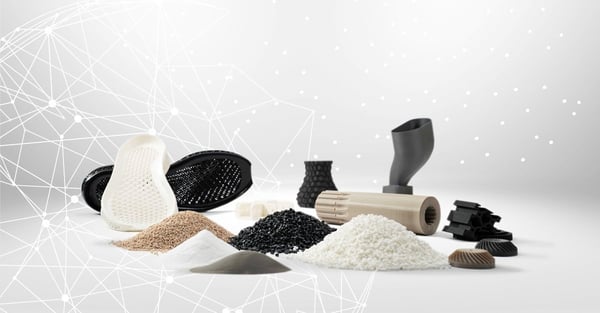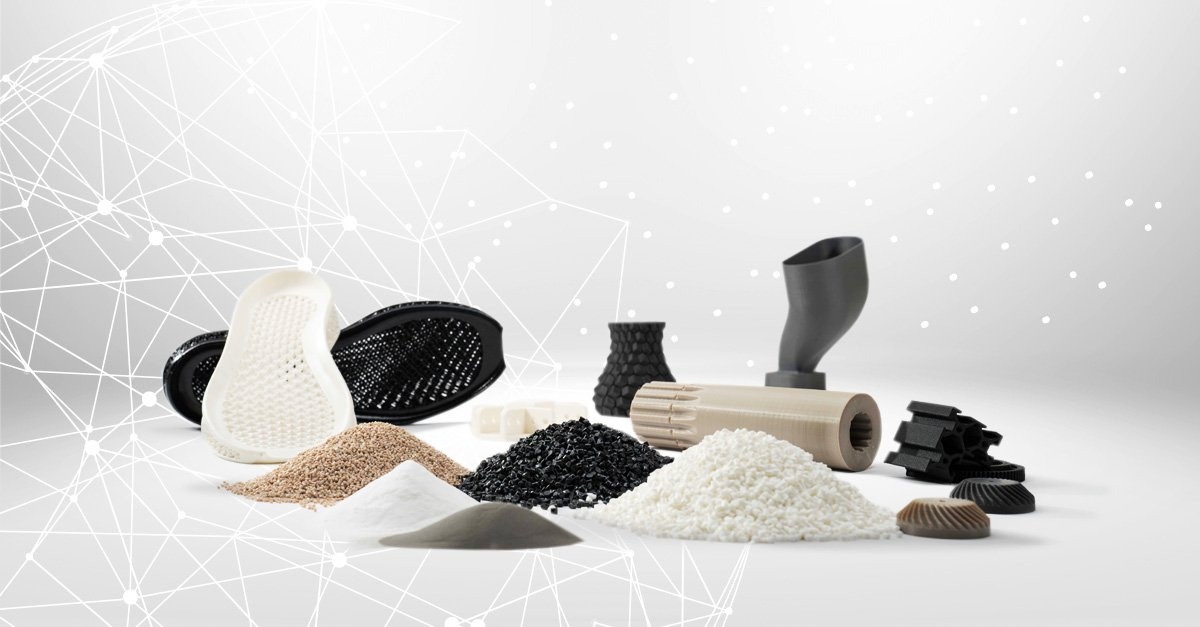Innovative and sustainable plastics for industrial additive manufacturing

With the LUVOSINT and LUVOCOM 3F materials, the LEHVOSS Group offers optimized materials for industrial 3D printing.
These materials enable the quality-assured production of additively manufactured components. In the following, we will introduce you to various LUVOSINT and LUVOCOM 3F materials and their possible applications in practice.
LUVOCOM 3F eco PET: Sustainable solutions and replacement of non-recyclable materials
The demand for sustainable material is growing in many industries - including in 3D printing. To respond to this trend, the LEHVOSS Group developed LUVOCOM 3F eco PET. The material consists of 90% recycled PET. You can use LUVOCOM 3F eco PET for the FFF (Fused Filament Fabrication) and FGF (Fused Granulate Fabrication) processes.
Like all products from the LUVOCOM 3F line, the material impresses with its very good processability and many other product properties (see box). Possible areas of application are functional prototypes and series parts for numerous industries. These include, above all, mechanical engineering, automotive engineering and medical technology.
LUVOCOM 3F filaments: properties and background information
These filaments are designed for easy printability. With LUVOCOM 3F filaments you achieve excellent component properties and a high level of quality for prototypes and series parts.
TÜV SÜD, commissioned by the LEHVOSS Group and Ultimaker, has certified the 3D printing process in the combination of LUVOCOM 3F filament and Ultimaker printer. This includes the material properties, the production of the probe with dimensional tolerances, the production of the filament and the printing process.
LUVOCOM 3F PAHT is a polyamide-based material that is resistant to high temperatures. The material has the strength of a PA6. The water absorption of LUVOCOM 3F PAHT is significantly reduced and the absorption rate is significantly slower than with standard PA6.
LUVOCOM 3F PET is based on polyethylene terephthalate (PET). In contrast to PETG, PET is significantly more temperature-resistant. The material shows no tendency to warp and does not require any temperature-controlled installation space. Parts printed from LUVOCOM 3F PET have excellent surface properties. In many cases, this does not make post-processing necessary.
Further information about the various LUVOCOM 3F filaments can be found on our product pages.
LUVOCOM 3F eco PET 50291 BK: The first available product
LUVOCOM 3F eco PET 50291 BK is an unreinforced, black type with an excellent surface finish. With a temperature resistance of up to 125 °C with low water absorption, the material offers significant advantages over the PETG otherwise used in the 3D printing market.
LUVOCOM 3F PET CF 9780 BK: Creation of cost- and handling-optimized lamination standards
It is not just the development of sustainable materials that is becoming increasingly important. The reduction of the CO2 footprint must also be viewed holistically. The creation of cost- and handling-optimized lamination molds or lamination tools for the production of highly developed orthoses from CFRP laminates still takes place using thermoset PU molded foams. Large amounts of waste are created during milling and later disposal of the molds.
To this end, the LEHVOSS Group carried out a case study with the company adViva and other partners. The mold manufacturing process was examined using 3D printing. LUVOCOM 3F PET CF 9780 BK was selected as the material. When constructing the model, attention was paid to the use of minimal materials. Due to the high strength of the selected 3D printing material, low infill can be used. This enabled the amount of material used in the case study to be further minimized.
In these and similar 3D printing applications, LUVOCOM 3F PET CF 9780 BK could be collected separately and sent for technical plastics recycling. The creation of new technical parts, for example via injection molding, would be possible after the components have been ground. With the establishment of such a process in this application, a sorted return of material could be organized. Nothing stands in the way of recycling.
If you want to find out more about the cooperation between the LEHVOSS Group and adViva, we recommend our white paper "Case Study: 3D printed molds for orthotics":
LUVOSINT materials and their areas of application
LUVOSINT materials are powders that are suitable for the laser sintering process and other powder-bed-based 3D printing processes.
Overview of LUVOSINT materials
LUVOSINT TPU is a solid, abrasion-resistant and elastic material. Due to its processing window and the fact that the powder cake can be completely recycled, it is particularly suitable for the production of end components, even in large quantities.
LUVOSINT PP is a tough, hard PP type based on a random copolymer. The powder has an extraordinary chemical resistance in aggressive atmospheres or media. Due to its high melting point and HDT value, the material retains the aforementioned properties even at higher temperatures.
LUVOSINT PA portfolio - On the basis of various polyamides such as PA12 and PA6, various materials have been developed for the requirements of 3D printing and applications in various industries. The materials have very good mechanical properties, are easy to process and are colored directly black, among other things.
You can find more information about the LUVOSINT materials on our product website.
Use of LUVOSINT in automotive engineering
LUVOSINT materials based on PP, PA12 and PA6 are perfect for the requirements of the automotive industry. These are inexpensive and completely reusable. You do not have to dispose of used powder. LUVOSINT materials for the automotive sector are already completely black. You no longer have to worry about an additional dyeing process.
Due to its high stability, it is possible to run the LUVOSINT PA6 8834 BK with higher oxygen contents in SLS machines and to save a lot of nitrogen. The LEHVOSS Group is working on LUVOSINT PA12 9270 BK together with cirp GmbH, an SLS service provider for the German automotive industry. The work of cirp GmbH focuses on high-quality automotive components.
Use of LUVOSINT for hybrid technologies
The perfect application example for a hybrid technology? This includes, for example, the combination of SLS powder printing and traditional casting. NEMETON relies on such a hybrid concept. The Austrian engineering and 3D printing company has invented a new bicycle saddle - also known as a Blobber.
The Austrian company is an expert in polyurethane processing and is increasingly relying on LUVOSINT TPU X92A. Behind Blobber is a new concept for the individual adjustment of bicycle saddles. The upper part of the inflatable and removable upper part of the saddle consists of a shell. This must be made with PU casting. The shell is built around an inner SLS printed lattice structure. This is exactly where LUVOSINT TPU X92A is used.
This hybrid concept guarantees the NEMETON product performance, comfort and cost efficiency. The engineering and 3D printing company's Blobber saddle will soon be on display on public rental bikes in Austria.
Would you like to experience LUVOSINT and LUVOCOM 3F eco PET up close? The LEHVOSS Group will present these and other innovative, polymer-based materials for sophisticated 3D printing at Formnext 2021.
We will show you how high demands of the end customers with regard to product quality, reproducibility and processability are taken into account - the focus is of course on sustainability and economic efficiency.


